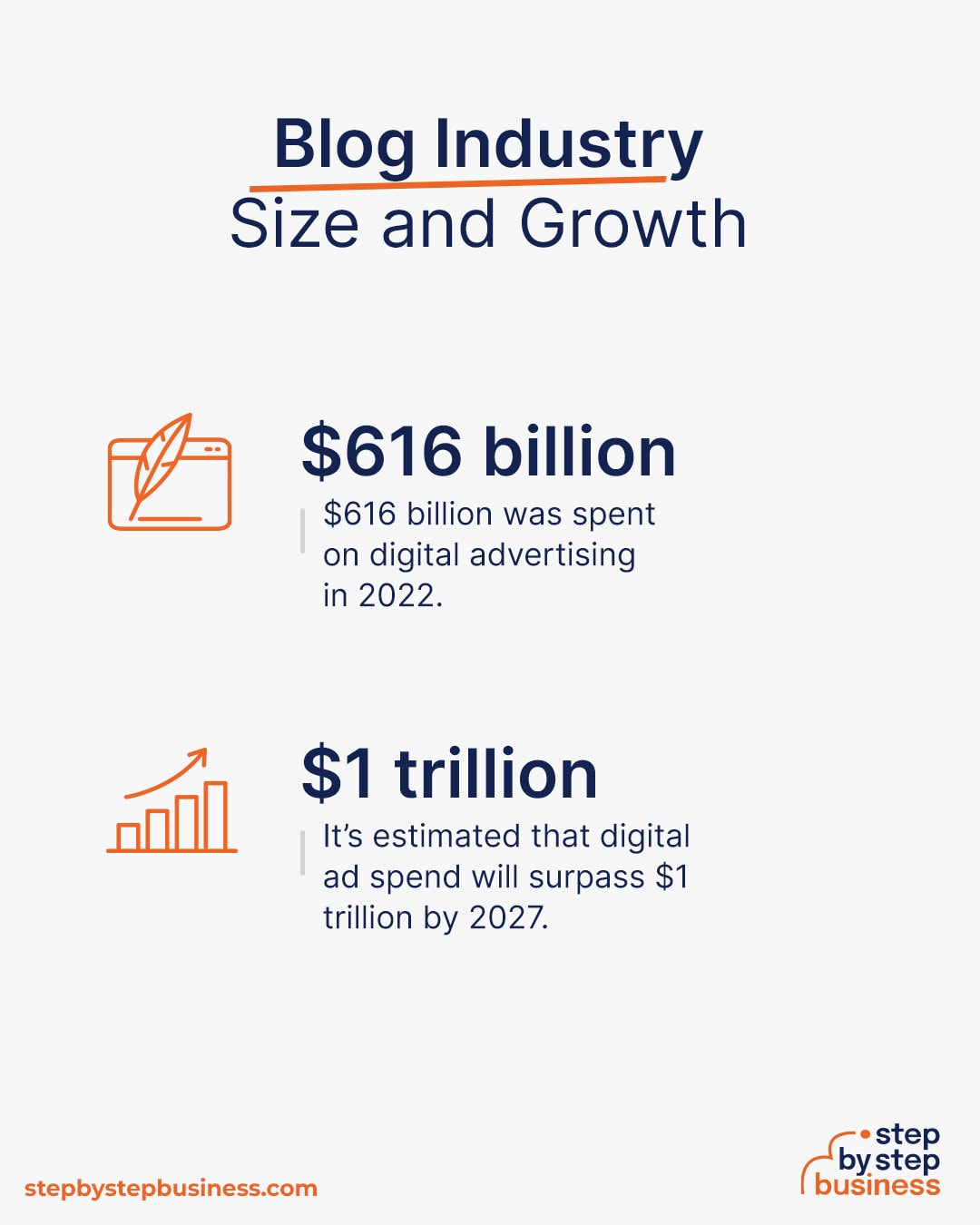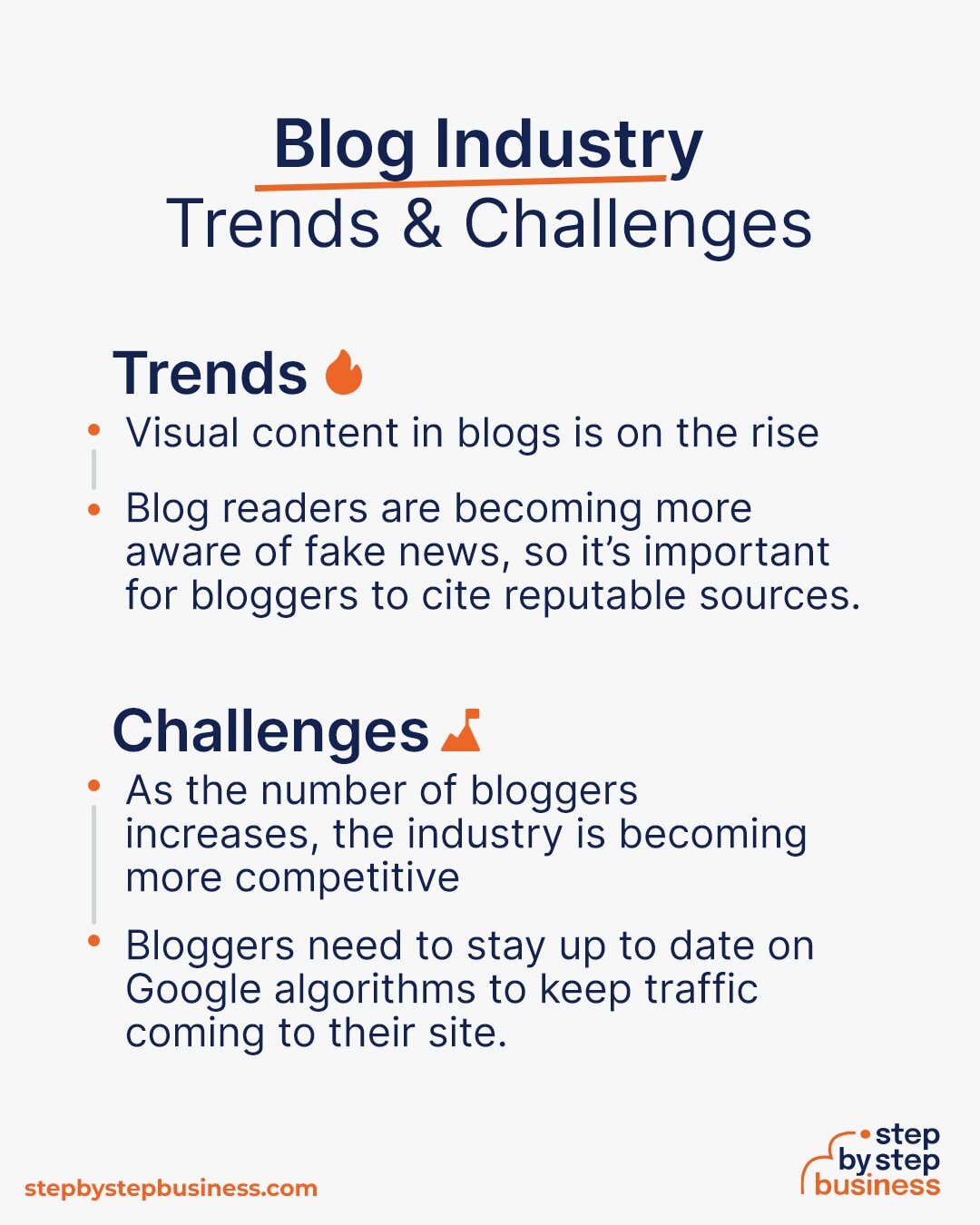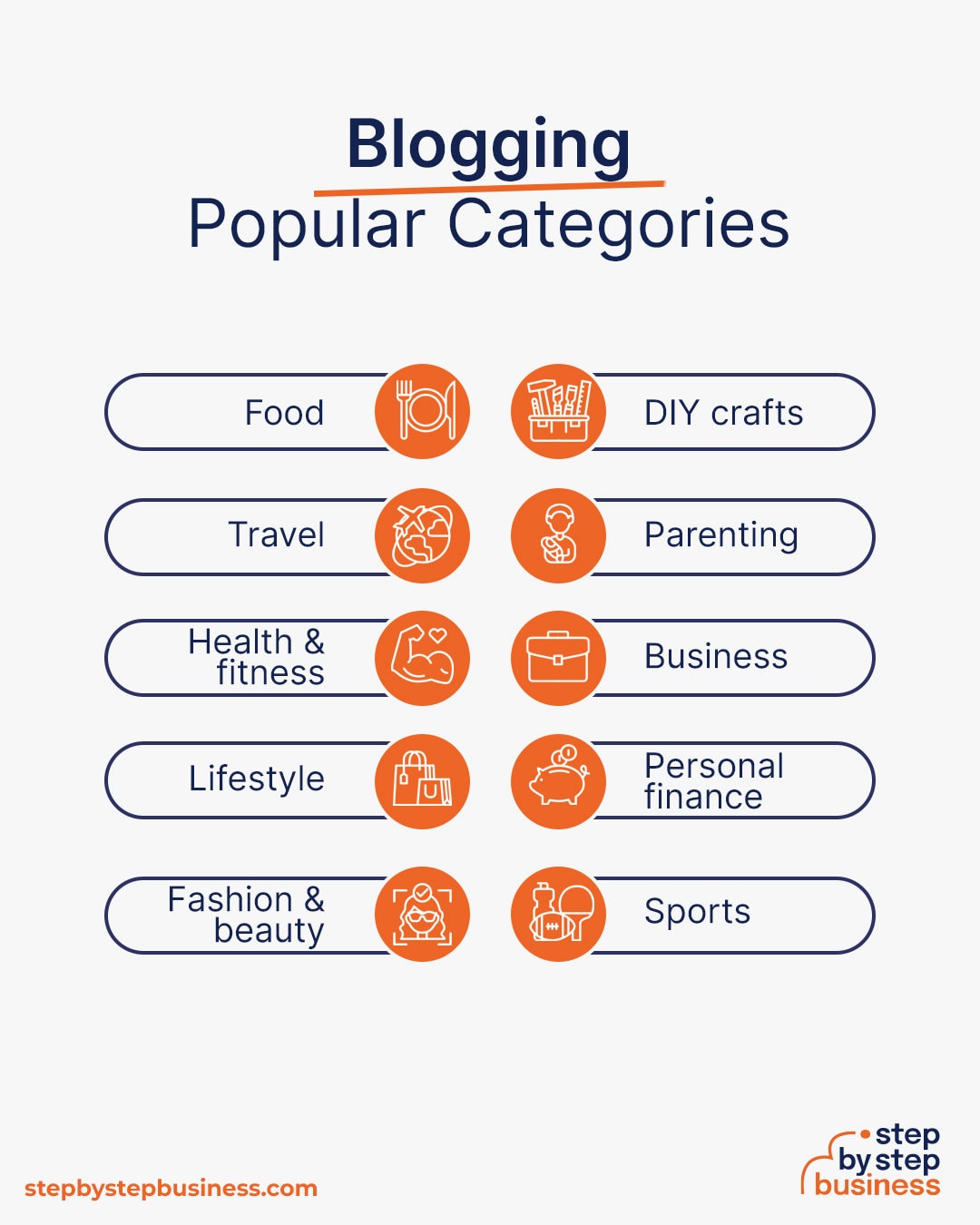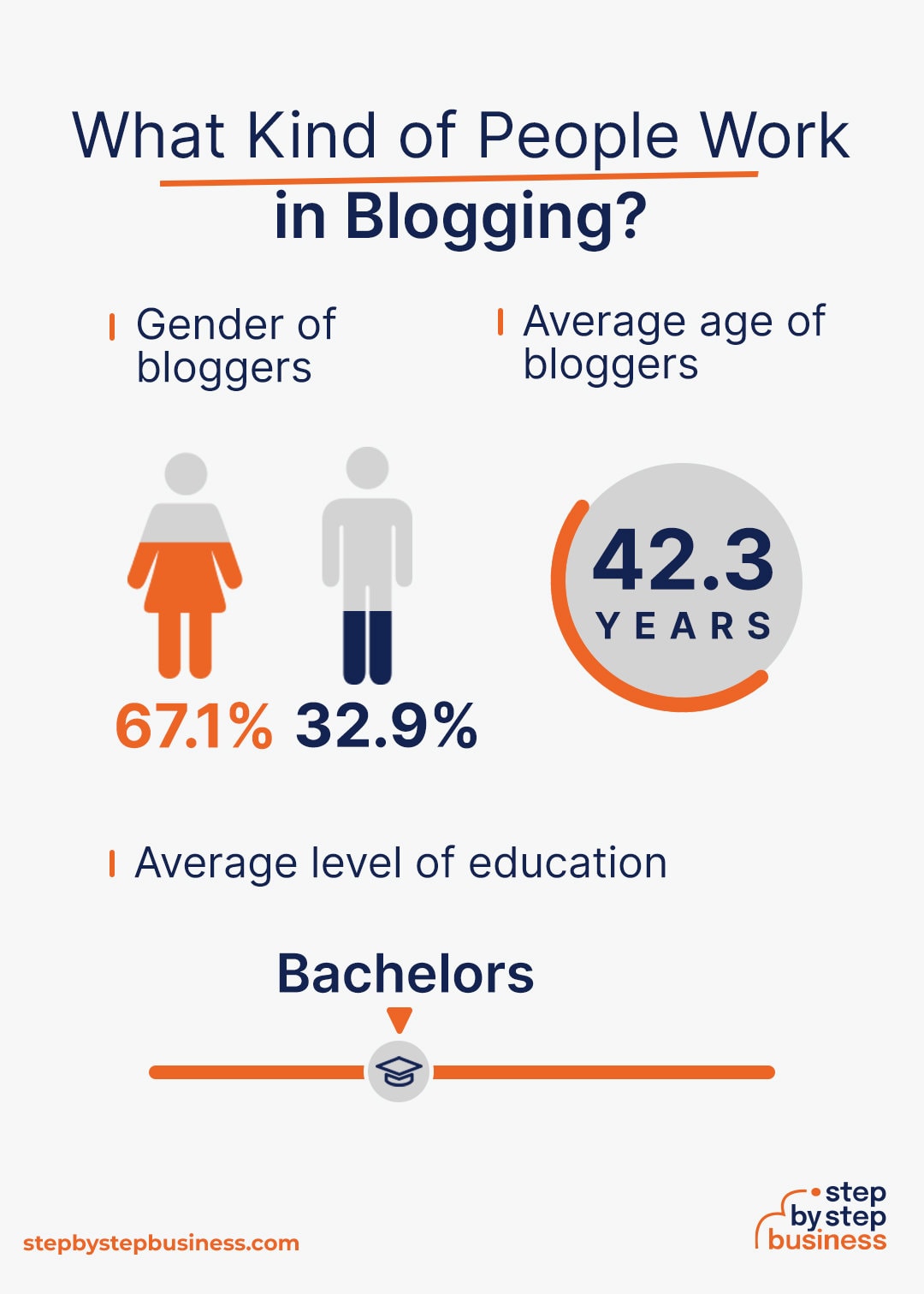Here are the most important things to consider when starting a blog:
- Identify your niche — Focus on a specific topic you’re passionate about or have experience in.
- Build a website — We recommend WordPress as the best platform for bloggers, but here are other website builders we also recommend.
- Write quality content — Regularly publish informative, original articles. Try to stand out from the crowd and do something different and original. People will reward it.
- Register your business — A limited liability company (LLC) is the best legal structure for new businesses because it is fast and simple. Form your business immediately using ZenBusiness LLC formation service or hire one of the best LLC services on the market.
- Learn SEO — Use keywords and optimize for search engine visibility. However, write for your audience, not search engines.
- Diversify your income streams — Don’t just rely on one channel like Google. Pinterest has become very popular among bloggers (especially if your niche is visual like home design, tattoos, recipes, beauty and makeup). Start a YouTube channel. Promote your content on social media and build a social following. And don’t forget the importance of email marketing.
Interactive Checklist at your fingertips—begin your blog today!
Download Now
1. Decide if Blogging Is Right for You
Blogging is not for everyone. It requires coming up with new post ideas daily and creating engaging content that will connect with readers. It also requires taking steps to get readers to your blog, which can be time-consuming and expensive unless you’re a search engine optimization wiz.
It also takes a significant amount of time to get enough traffic to be able to monetize your site and make a livable income. For most people, that means pulling double duty — working at a job while building their blog in their spare time.
But once you gain traction, you can make money from your blog in a few different ways, which can add up to a decent income. If you have the time and money to put into building a successful blog, it can be very worthwhile financially.
Blogging also gives you the opportunity to educate, entertain, or influence people in other ways, any of which can be very fulfilling.
Just make sure that you know what you’re getting into before you jump in and start posting away. Here’s some information that may help.
Pros and Cons
Pros
- Educate, entertain, inspire — Share knowledge, entertain, and inspire a wide audience through diverse content
- Good long-term profit potential — Blogs have the potential to generate substantial income over time through various monetization strategies
- Growing market — The increasing demand for online content positions blogs as valuable information sources
- Builds personal brand or business authority — Regular quality posts can establish your authority in a niche, attracting more opportunities
- Flexibility and creative outlet — Blogging offers a flexible schedule and a platform for creative expression
Cons
- Takes time to monetize — Developing a reliable income from a blog is a slow process requiring patience
- Some writing ability required — Effective communication and basic writing skills are crucial for success
- Market saturation and visibility challenges — Standing out among millions of blogs and building a dedicated readership can be challenging
Blogging Industry Trends
Industry Size and Growth
As a blogger, you’ll be earning money from ads on your site, so essentially you’ll be part of the digital advertising industry.
Blogging Trends and Challenges
Trends
- Visual content on the rise — Incorporating images, videos, and infographics has become crucial as visual content enhances user engagement and information retention
- Increased awareness of fake news — Readers are becoming more discerning, necessitating transparency and accurate sourcing from bloggers to maintain credibility
- Mobile optimization — With the growing use of smartphones, optimizing blogs for mobile devices is essential to provide a seamless user experience
- Interactive content — Implementing quizzes, polls, and interactive infographics can increase user engagement and time spent on the site
- Integration with other platforms — Bloggers are integrating their content with social media and other platforms (Instagram, Tik-Tok, Pinterest) to increase visibility, engagement, and cross-platform presence
Challenges
- Increased competition — The influx of new bloggers saturates the market, making it harder for individual blogs to stand out
- Keeping up with SEO — Staying updated with Google’s ever-evolving algorithms is vital for maintaining and improving search engine rankings
- Adapting to changing reader preferences — Bloggers need to continually assess and adapt to shifts in reader interests and preferences to keep content relevant
- Time management — Producing consistent, high-quality content requires significant time investment, posing a challenge for bloggers to balance blogging with other responsibilities
- Demonstrating expertise — Establishing and showcasing your experience and expertise on a topic has become increasingly important
Popular Types of Blogs
The most popular blog categories are:
What Kind of People Work in Blogging?
- Gender — 67.1% of bloggers are female, while 32.9% are male.
- Average level of education — The average blogger has a bachelor’s degree.
- Average age — The average blogger in the US is 42.3 years old.((https://www.zippia.com/blogger-jobs/demographics/))
How Much Does It Cost to Start a Blog?
Startup costs for a blog range from $2,500 to $5,600. The largest expenses are a computer and a marketing budget.
| Start-up Costs | Ballpark Range | Average |
| Setting up a business name and corporation | $100–$500 | $300 |
| Business licenses and permits | $100–$300 | $200 |
| Insurance | $100–$500 | $300 |
| Website (domain and hosting) | $500–$1,000 | $750 |
| Computer | $1,000–$2,000 | $1,500 |
| Software and blog platform | $100–$300 | $200 |
| Initial sales and marketing budget | $500–$1,000 | $750 |
| Total | $2,400–$5,600 | $4,000 |
How Much Can You Earn From a Blog?
It’s extremely difficult to predict a blog’s earnings. It will depend on the quality of your content and how much you put into getting traffic. Your blog’s earnings will depend on the following factors:
- Content quality — Attract and retain a loyal audience with high-quality, engaging content
- Traffic — More traffic increases potential earnings, particularly for advertising-based revenue
- Niche — Lucrative niches offer higher earning potential due to advertiser demand and affiliate opportunities
- Monetization — Diversify income through affiliate marketing, sponsored posts, product sales, and advertising
- Audience engagement — An engaged audience is more likely to generate revenue through affiliate links and product purchases
- Time investment — A significant time investment is required to build and maintain a profitable blog
- SEO and visibility — Optimize content for search engines to drive organic traffic and sustain earnings
- Networking — Form partnerships and collaborations for exposure and potential income opportunities
- Consistency — Maintain a regular posting schedule to build trust and keep your audience engaged
- Marketing — Promote your blog through various channels to increase traffic and potential earnings
- Adaptability — Stay adaptable to trends, algorithm updates, and audience preferences
- Investment in resources — Invest in tools, courses, and resources to enhance your blog’s earning potential
- Experience — Leverage your growing experience to optimize strategies for increased earnings
- Location and demographics — Consider the impact of your audience’s location and demographics on earning potential
If you do well, you could potentially start making over $100,000 per year, but it takes a significant amount of time to get to that level.
2. Determine Your Purpose and Niche
Most blogs have a specific theme, posting about a specific subject, such as fashion, travel, business, or anything else you can think of. They also have a purpose, whether to educate people, recommend favorite products, promote a cause, or just to make people laugh.
Choosing a niche is important because you’ll be targeting a specific audience. Over time, you’ll learn more about that audience, such as their interests, demographics, and what social media they visit. That way you can create content that’s relevant to them, making them more likely to engage with it. You’ll also be able to focus your marketing in the right places.
When deciding on a niche, consider areas where you have expertise/experience and that you’re interested in. You want to choose a niche that you have knowledge of, but also that you’re passionate about. But since your blog will be your business, it also has to be a niche that can be profitable.
Profitability will depend on what people are interested in, which you can find out by doing some keyword research to find trending searches for specific topics. Google Trends is a good place to start with. You’ll also need to determine how you can monetize a blog in a specific niche. You can find out by looking at similar blogs to see what strategies they’re using.
Now, the caveat is that you don’t necessarily want to choose the most profitable niche because you’ll have more competition. The most profitable niches tend to be over-saturated. Your best bet is to choose a niche that’s profitable, but not too close to the top of the profitability list.
3. Decide on a Blog and Domain Name
The name you choose for your blog is very important, since it’s the first chance you have to capture the readers’ attention. You want it to be simple enough to remember but have some connection to the theme of your blog. That will help your blog to get found on search engines, as will the related domain name.
When choosing a name, also consider the purpose of your blog. Are you trying to inspire, educate, or entertain? Try writing a paragraph describing your goals for your blog. It may help you to come up with words that you might want to include in your name.
You can also use a business name generator to give you ideas. Make sure that the name is unique, easy to spell, and descriptive enough to capture attention.
You’ll also need to check to make sure the domain name is available to use. A .com name is preferable, although .net or .org are acceptable. You can use our Domain Name Search Tool below to check availability.
Find a Domain
Powered by GoDaddy.com
When choosing a domain name for your blog, also ensure that the corresponding social media handles are available to maintain brand consistency across platforms.
After you’ve decided on the domain name, the next step is choosing the hosting provider for your blog. Your hosting provider stores your website files and makes your blog accessible to visitors. A reliable host ensures fast loading times, minimal downtime, and secure data storage.
Best Hosting Recommendations
- Bluehost — Popular for its affordability and strong performance, ideal for WordPress blogs. Prices start at $2.95/month
- SiteGround — Known for excellent customer service and high-speed performance. Plans start around $2.99/month, offering advanced caching for faster load times
- HostGator — Offers a range of hosting options with strong uptime guarantees. Shared hosting plans begin at $2.75/month.
- A2 Hosting — Provides fast server speeds and reliable performance, with prices starting at $2.99/month for shared hosting
4. Choose a Blogging Platform
When evaluating blogging platforms, consider your long-term goals and the features that are most important to you. Look for platforms that offer robust customization options, as this will allow you to create a unique and branded experience for your readers.
WordPress, for example, offers thousands of themes and plugins, enabling you to add functionality and design elements to your site.
Additionally, think about the ease of use. Platforms like Wix, Weebly, and Squarespace are known for their user-friendly interfaces, making them a great choice for beginners. They offer drag-and-drop features, allowing you to build your blog visually without needing to know how to code.
It’s also important to consider the SEO capabilities of the platform. Having a blog that’s optimized for search engines is crucial for attracting organic traffic. WordPress is renowned for its SEO-friendly features and plugins (Rank Math, Yoast) but many other platforms also offer built-in SEO tools.
Another aspect to consider is the platform’s scalability. As your blog grows, you’ll want a platform that can grow with you, accommodating increased traffic and additional content without compromising performance.
Lastly, take a look at the support and community surrounding the platform. Having access to helpful resources and a community of users can be invaluable, especially when you’re just starting out. Platforms like WordPress have a massive community of developers and users, providing extensive forums, tutorials, and third-party services.
5. Design Your Blog
Designing a blog starts with creating an eye-catching home page. It needs to clearly convey what your blog is about, and capture the reader’s interest.
Visual appeal is very important when it comes to blogs. You want your site to be visually appealing but not cluttered. No one wants to read huge blocks of text, but they also don’t want sensory overload. You have to balance simplicity with elements of interest.
Color is also important, as people tend to make associations with color, which is called color psychology. For example, red makes people hungry, so a cooking blog might choose a red theme. Blue creates a sense of trust, so it might be appropriate for an educational blog.
Also, each time you create a new post, try to include images or graphics that will break up the text. For example, if you quote a statistic, create a related graphic. You can easily find images and graphic design tools online. However, don’t be afraid to have white space on your pages. It keeps your blog simpler and cleaner.
Be sure to display thumbnails of your posts in a list form. This helps readers to browse and choose the posts that they’re interested in reading. Additionally, each post should have a title, a picture, and a date.
To entice readers to stay on your blog, show related content on each of your posts. These should be your other posts that the reader may find relevant.
From a technical perspective, your blog should also have a responsive design, meaning that it automatically adapts to the reader’s preferences and device.
Consulting a web designer when setting up your blog can be wise decision as they possess the expertise to create a visually appealing and user-friendly interface, ensuring a positive user experience that can significantly contribute to retaining visitors and boosting your blog’s credibility.
6. Develop Quality Content
Crafting exceptional content goes beyond just being a good writer; it requires a strategic and visually engaging approach to capture your audience’s attention and trust. Even if writing isn’t your strongest suit, a conversational and relatable tone can create a strong connection with your readers.
Starting with a well-thought-out content plan sets a solid foundation for your blogging journey. Utilize tools and resources to brainstorm and select topics that resonate with your target audience. Kick off your content creation process by listing down a variety of topics to cover, ensuring a good mix to maintain your audience’s interest.
To perform keyword research for your blog, utilize tools like Google Keyword Planner or Semrush to identify popular yet not overly competitive search terms related to your niche. Focus on a mix of short-tail and long-tail keywords, and integrate them naturally into your content and headings.
Use Google’s auto-suggest and related search features for additional keyword ideas, aiming to improve your blog’s search engine visibility and drive targeted traffic.
Incorporating compelling and attention-grabbing headlines is crucial; they are the first thing your readers see and play a significant role in drawing them in. Make sure your content is structured, avoiding long, intimidating blocks of text. Break up your content using headings, bullet points, and short paragraphs to enhance readability.
When it comes to specific types of blogs, authenticity, and proof go a long way. For product or service reviews, show that you have personally tried or tested what you are endorsing. Share screenshots, videos, or any form of tangible evidence to build trust and credibility. If your blog revolves around travel, share personal stories and photographs from your trips instead of relying on stock images. Similarly, for food blogs, visuals of the cooking process, or the final dish, especially if prepared by you, add a personal and trustworthy touch.
Visual elements are a must in today’s digital age. Integrate relevant images, infographics, videos, or any form of media that adds value to your content. This not only makes your posts more appealing but also aids in better understanding and retention of information.
Lastly, if you’re looking to expedite your blog’s growth, considering hiring a freelance writer could be a strategic move. Platforms like Upwork and ProBlogger provide a vast pool of talented writers, ensuring you can find someone who aligns with your blog’s tone and niche, helping to consistently produce high-quality content.
7. Register Your Business
If your blog generates income, it becomes necessary to establish a formal business entity.
Business entities come in several varieties, each with its pros and cons. The legal structure you choose for your blog will shape your taxes, personal liability, and business registration requirements, so choose wisely.
Here are the main options:
- Sole proprietorship — The most common structure for small businesses makes no legal distinction between company and owner. All income goes to the owner, who’s also liable for any debts, losses, or liabilities incurred by the business. The owner pays taxes on business income on his or her personal tax return.
- Partnership — Similar to a sole proprietorship, but for two or more people. Again, owners keep the profits and are liable for losses. The partners pay taxes on their share of business income on their personal tax returns.
- Limited Liability Company (LLC) — Combines the characteristics of corporations with those of sole proprietorships or partnerships. The owners are not personally liable for the debts of the company.
- C Corporation — Under this structure, the business is a distinct legal entity and the owner or owners are not personally liable for its debts. Owners take profits through shareholder dividends, rather than directly. The corporation pays taxes, and owners pay taxes on their dividends, which is sometimes referred to as double taxation.
- S Corporation — An S Corporation refers to the tax classification of the business but is not a business entity. An S Corp can be either a corporation or an LLC, which just needs to elect to be an S Corp for tax status. In an S Corp, income is passed through directly to shareholders, who pay taxes on their share of business income on their personal tax returns.
We recommend that new business owners choose an LLC as it offers liability protection and pass-through taxation while being simpler to form than a corporation. You can form an LLC in as little as five minutes using an online LLC formation service. They will check that your business name is available before filing, submit your articles of organization, and answer any questions you might have.
8. Promote Your Blog
Now you’re ready to start publishing your content and market your blog. Here are some powerful digital marketing strategies for blogs:
- Leverage social media platforms —
- A blog can utilize Facebook by leveraging its advertising platform to target specific demographics via Meta Ads, sharing engaging content, and fostering community through groups and interactive posts to drive traffic and increase visibility.
- Instagram and Pinterest are ideal for creative businesses with a high visual aspect, such as food blogs, travel blogs, DIY and craft blogs, and home design blogs, as these platforms enable visual promotion of your content, effectively attracting diverse target audiences.
- With over 1 billion monthly active users, predominantly from a younger demographic, TikTok offers a massive platform for promotion.
- LinkedIn is a vital space for B2B bloggers to share content and network with industry professionals.
- Email marketing and newsletters — Send personalized and regular emails to your subscribers, keeping them engaged and informed about your latest content.
- Influencer marketing — Collaborate with influencers, including micro-influencers with smaller followings but potentially higher engagement rates, to promote your blog.
- Start a podcast — Create a personal connection with your audience by starting a podcast related to your blog’s niche.
- Offer free downloads — Provide valuable resources for download on your website, encouraging visitors to leave their email addresses.
- Create and share infographics — Design informative and visually appealing infographics to enhance your content and share on social media.
- Guest posting — Write and publish articles on other reputable blogs in your niche to expand your reach and establish authority.
- Engage in online communities — Participate in forums, groups, and discussions related to your niche to build relationships and direct traffic to your blog.
- Collaborations and partnerships — Partner with other bloggers or brands in your niche for mutual promotion.
Optimize Your Blog for SEO
Optimizing your blog for SEO is crucial for increasing visibility and attracting organic traffic. Start with the basics — craft compelling titles and meta descriptions and utilize headings throughout your posts to enhance readability and provide structure.
Ensure that your images are optimized for fast loading and include descriptive alt tags to improve accessibility and context for search engines.
To enhance user experience and improve SEO rankings, prioritize optimizing your blog’s loading speed by compressing images, leveraging browser caching, and minimizing HTTP requests.
Strengthen the internal linking structure of your site to guide users and search engines to related content.
Organize your posts into categories to create a clear site architecture, ensuring that visitors can easily find and navigate through your content.
Make your About page stand out; this page is pivotal in establishing trust and credibility with your audience. Showcase your expertise, experience, and accomplishments to build a strong connection with your readers.
Adhere to Google’s E-E-A-T guidelines by demonstrating experience, expertise, authoritativeness, and trustworthiness in your field. Showcase your knowledge and skills through detailed, well-researched content, backed by reputable sources and real-life examples or case studies.
While applying SEO strategies is crucial for improving search visibility, always prioritize writing for readers first, ensuring your content is engaging, valuable, and accessible, as catering to your audience’s needs and interests ultimately leads to better SEO results. Humans first, SEO comes after.
9. Engage with Your Audience
Engaging with your audience on a blog goes beyond responding to comments; it involves creating a community and fostering a sense of belonging among your readers. In addition to being active and positive in the comments section, consider incorporating the following strategies to enhance audience engagement:
- Ask questions — At the end of your blog posts, pose thought-provoking questions to encourage readers to share their opinions and experiences.
- Create polls and surveys — Use polls and surveys to gather feedback and understand your audience’s preferences.
- Run contests and giveaways — Organize contests and giveaways with prizes relevant to your niche. This creates excitement and encourages participation, potentially increasing your blog’s visibility and attracting new readers.
- Share user-generated content — If your readers share stories, photos, or experiences related to your blog’s content, highlight them in your posts or on your social media channels.
- Newsletter sign-ups — Encourage readers to subscribe to your newsletter and use it as a platform to share exclusive content, updates, and engage with your audience on a more personal level.
- Personal stories and anecdotes — Share your own experiences and stories related to your blog’s topic.
- Timely and relevant content — Publish content that is current and relevant to your audience’s interests and needs. Stay updated on trends within your niche and reflect that in your blog posts.
- Interactive content — Incorporate quizzes, interactive infographics, or videos to make your content more engaging and shareable.
10. Monetize Your Blog
Monetizing your blog becomes viable once it attracts considerable traffic, providing multiple revenue streams to explore. Selling ad space directly to advertisers can be lucrative, especially if your blog garners popularity, prompting brands to approach you for advertising opportunities. Alternatively, ad networks such as Mediavine and Raptive offer a streamlined way to connect with advertisers, with potential earnings scaling with your traffic.
Engaging in affiliate marketing is another lucrative avenue, where you partner with businesses, promoting their products through affiliate links embedded in your content, earning a commission for each sale generated through these links. Additionally, consider leveraging your blog’s influence by collaborating with brands for paid promotions and sponsored product or service reviews, turning your platform into a valuable advertising space for relevant industries.
Diversifying your income streams, you can also offer your own products or services, such as e-books, e-courses, or consulting services, directly on your blog. For a more exclusive experience, a subscription-based model can be introduced, providing subscribers with access to premium content and special offers.
Furthermore, capitalize on your expertise and the authority of your blog by participating in industry events as a speaker, which not only enhances your credibility but also opens doors for additional income opportunities and networking.
To ensure financial stability and reduce risk, diversify your blog’s income streams by exploring various monetization methods such as affiliate marketing, sponsored content, and selling digital products, rather than relying solely on one channel like ad revenue.
11. Stay Consistent and Evolve
The key to a great blog is to continuously post content and keep a consistent tone. However, you need to follow trends and evolve your content based on what’s happening in your niche. For example, a cooking blog should follow popular food trends. You can also be a trendsetter by writing about something you like and singing its praises.
The point is that a blog cannot stand on its own. You need to constantly add content, keep it up to date, and give readers what they want.
Common Questions
How do bloggers get paid?
Bloggers earn through methods like advertising, affiliate marketing, sponsored content, selling products, donations, and subscription models.
How can I start a blog for free?
Begin by choosing a blogging platform such as WordPress.com, Wix, or Squarespace. Sign up, select a domain name, customize your blog’s design, create and publish content, and promote it through social media.
Do bloggers make much money?
Bloggers’ earnings vary based on factors like niche, audience size, content quality, and monetization strategies. Within the first year, bloggers can make $200–$1,000 per month. On average, a successful and established blogger can make around $35,000–$55,000 per year.
How can I start a blog with no experience?
Choose a niche you’re passionate about, use a user-friendly platform like WordPress, register a domain name, set up hosting, create content tailored to your audience, and engage with readers to learn and improve.


































Comments